Birthstones guide by month.
For your purchases of precious or semi-precious stones, please contact us at 450-818-0119 or at [email protected]. Come see us at 150, Chemin de la Grande-Côte, Rosemère.
www.dominicdufourjoaillier.com
-------------------------------------------------------------------------------------------------------------------------------------------------------------------
A birthstone is a gemstone that represents a person's month of birth.
Garnet (january)
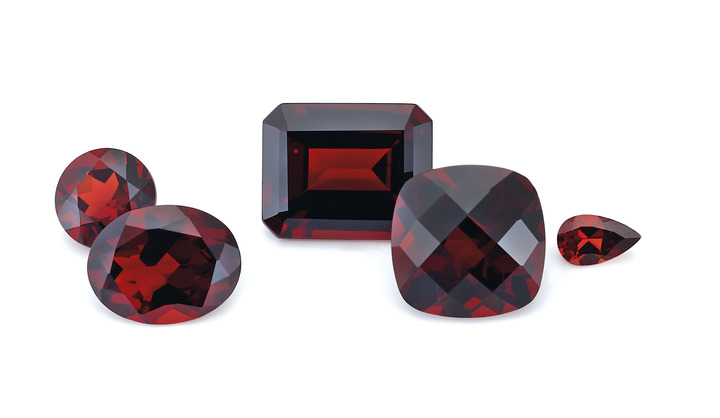
Garnets, traditionally considered ‘semi-precious’, are a large group of minerals containing two isomorphic series. The aluminium and calcium series share a common structure with each variety having slightly different chemical compositions.
Garnets are rarely ‘pure’ varieties and are more often combinations containing mixtures of the interchangeable chemical elements. This results in slightly different physical and optical properties among the numerous different varieties.
Most people are familiar with the red pyrope and almandine garnets while few people know that garnets also come in rich green (tsavorite), vibrant yellowish-green (demantoid), vivid orange (spessartine ‘mandarin’), brownish orange (hessonite), and numerous shades of pink, purple, and yellow. With the exception of blue garnet can be found in virtually all colours.
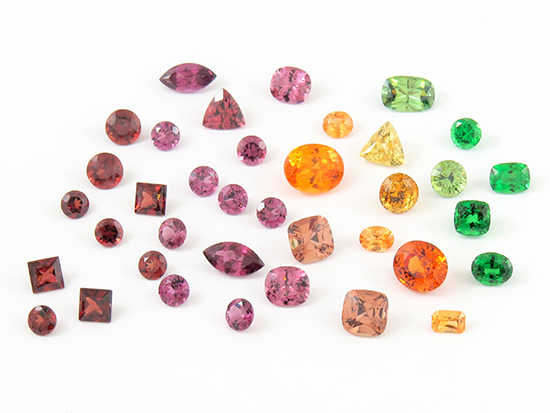
Garnet Fact Sheet
All garnets display bright vitreous lustre even though the hardness of the different varieties varies between 6.5 and 7.5 on the Mohs scale. With the exception of demantoid, which is slightly fragile, garnets are very stable and resistant gems suitable for all types of jewellery. Different garnet varieties can display moderate to very strong dispersion however this ‘fire’ is often masked by the gem’s body colour. Garnets can occasionally display optical phenomena including cat’s eye (chatoyancy) effect and asterism (4 or 6 rayed star). The rare colour change garnet variety shows a bluish-green colour in daylight and a purplish-red colour in incandescent light.
Producing Countries
Garnet deposits are found in Brazil, Mozambique, Madagascar, Afghanistan, Pakistan, and Canada. They occur in metamorphic or igneous rocks and can also be found as water-worn pebbles in alluvial deposits. Garnets crystallize in the cubic system and rough garnet crystals are usually rhombic dodecahedrons (12 faces) or icositetrahedrons (24 faces). Red garnets are often found in close proximity to ruby and spinel deposits.
Are garnets treated?
Garnet’s colour and clarity are not significantly improved by heating and therefore they are not routinely treated. When surface reaching fissures are present they may be filled with a resin treatment but this is not common. Most garnets on the market have not been treated.
Garnets in Jewellery
Garnet’s wide range of colours, bright vitreous lustre, and the fact that it is rarely treated make it a popular choice for jewellery. Its moderate hardness, good stability and lack of cleavage make most garnet varieties suitable for all jewellery styles. Transparent stones are facetted and translucent stones may be cut as cabochons. Very dark material can be used for sculpting intaglios. Garnet is the birthstone for the month of January and the gemstone of the 2nd wedding anniversary.
Value and Quality Criteria
As with most gems, the tone and saturation of the colour are the primary quality factor that determines value. For example, fine quality tsavorite garnet should display a rich, saturated, medium toned green. Stones that are too dark, too light, or show greyish overtones will have lower values.
A gem’s clarity will also have an impact on value. Some varieties of garnet are typically more included than others. Red hued garnets are often very clean with few inclusions while orange garnets often have inclusions that are visible to the unaided eye. As a general rule, most consumers prefer gems with few or no inclusions however demantoid garnet is an interesting exception to this rule. Its characteristic ‘horsetail’ inclusion is much sought after by gem enthusiasts and collectors. Lapidaries will carefully cut the stone in order to prominently display the inclusion.
The gem’s size will have a direct impact on the value especially for tsavorite and demantoid garnets as they are rarely found in sizes over 5 carats. Red varieties such as almandine and pyrope are commonly found in large sizes and even large stones have more accessible prices. The rarity of certain varieties will also factor into pricing.
As with all gems, the quality of the cut is an important value factor. Well-cut stones will display better brilliance and command a premium.
Fun Fact
Demantoid garnet shows a very high dispersion (fire) of 0.057, which is higher than that of diamond 0.044.
Amethyste (febuary)
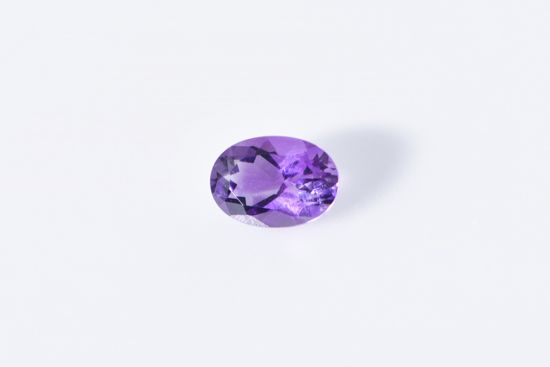
Quartz is one of the most abundant minerals in the Earth’s crust. Quartz is all around us everyday in rocks, sand, and even dust particles. Traditionally considered ‘semi-precious’, the vast quartz species contains many gem varieties.
Amethyst has sometimes been called semi-precious and yet historically it was once considered one of the most prized and valued gemstones. Amethyst became more affordable and accessible in the 19th century when large deposits were discovered in Brazil. Today both high-end jewellery houses and more commercial fashion jewellery manufacturers use amethyst in their creations. Uruguay and Brazil are the major producers of amethyst and deposits are also found in many other countries including Bolivia, India, Madagascar, Namibia, Russia, Sri Lanka, Zambia, and Zimbabwe. Amethyst can be heat treated to produce the yellow colour of citrine or the green colour of prasiolite. Ametrine is a colour-zoned quartz variety that displays both purple and yellow in the same crystal. The main source of ametrine is Bolivia.
Crystalline Quartz Fact Sheet
Crystalline quartz displays a vitreous lustre and has a hardness of 7 on the Mohs scale making it suitable for use in all types of jewellery. Quartz is generally quite affordable and has a good stability and toughness.
Aquamarine (march)
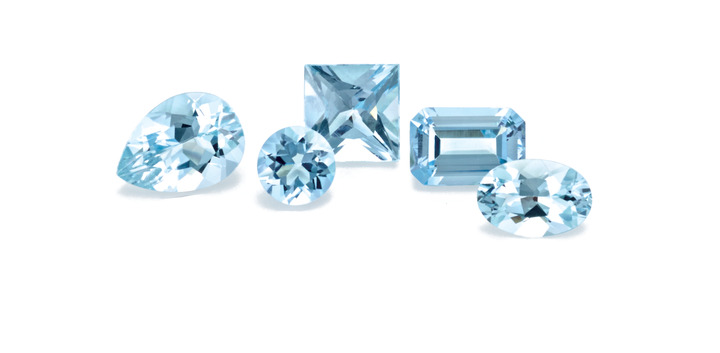 Aquamarine, traditionally considered as ‘semi-precious’, is a fine gemstone that belongs to the large beryl species* whose other varieties include emerald and morganite. The name aquamarine, from the Latin Aqua marinaen meaning ‘water of the sea’ perfectly describes the clear blue hues sometimes nuanced with green that are seen in the finest aquamarines. Aquamarine owes its blue tones to trace amounts of iron in its structure.
Aquamarine, traditionally considered as ‘semi-precious’, is a fine gemstone that belongs to the large beryl species* whose other varieties include emerald and morganite. The name aquamarine, from the Latin Aqua marinaen meaning ‘water of the sea’ perfectly describes the clear blue hues sometimes nuanced with green that are seen in the finest aquamarines. Aquamarine owes its blue tones to trace amounts of iron in its structure.
Aquamarine Fact Sheet
As with most beryls, aquamarine’s durability makes it a well-suited gem for use in jewellery. It is resistant and stable with a hardness of 7.5 on the Moh’s scale and a vitreous lustre.
Aquamarine and other beryls can occasionally show optical phenomena such as cat’s eye or star effects.
Producing Countries
Brazil is the primary source of gem quality aquamarine. However, deposits are also found in Russia, Madagascar, Myanmar, Nigeria, Kenya, Sri Lanka, Zimbabwe, Zambia, Namibia, and the United States.
Aquamarine crystals often form in pegmatic deposits producing large well-shaped crystals.
Is aquamarine treated ?
Natural saturated blue aquamarines do exist however; aquamarines with hints of green may be treated to eliminate the greenish tint producing a more pure and intense blue colour. The resulting colour is stable.
Aquamarine in jewellery
Aquamarine has long been a popular choice amongst jewellers and their customers. The hardness and tenacity of aquamarine make it an excellent choice for rings and bracelets and its stability allows it maintain its beauty over time.
Diamond (april)

Diamond is a solid form of the element carbon with its atoms arranged in a crystal structure called diamond cubic. At room temperature and pressure, another solid form of carbon known as graphite is the chemically stable form, but diamond almost never converts to it. Diamond has the highest hardness and thermal conductivity of any natural material, properties that are utilized in major industrial applications such as cutting and polishing tools. They are also the reason that diamond anvil cells can subject materials to pressures found deep in the Earth.
Because the arrangement of atoms in diamond is extremely rigid, few types of impurity can contaminate it (two exceptions being boron and nitrogen). Small numbers of defects or impurities (about one per million of lattice atoms) color diamond blue (boron), yellow (nitrogen), brown (defects), green (radiation exposure), purple, pink, orange or red. Diamond also has relatively high optical dispersion (ability to disperse light of different colors).
Most natural diamonds have ages between 1 billion and 3.5 billion years. Most were formed at depths between 150 and 250 kilometres (93 and 155 mi) in the Earth's mantle, although a few have come from as deep as 800 kilometres (500 mi). Under high pressure and temperature, carbon-containing fluids dissolved minerals and replaced them with diamonds. Much more recently (tens to hundreds of million years ago), they were carried to the surface in volcanic eruptions and deposited in igneous rocks known as kimberlites and lamproites.
Synthetic diamonds can be grown from high-purity carbon under high pressures and temperatures or from hydrocarbon gas by chemical vapor deposition (CVD). Imitation diamonds can also be made out of materials such as cubic zirconia and silicon carbide. Natural, synthetic and imitation diamonds are most commonly distinguished using optical techniques or thermal conductivity measurements.
The Canadian Government has set up a body known as the Canadian Diamond Code of Conduct to help authenticate Canadian diamonds. This is a stringent tracking system of diamonds and helps protect the "conflict free" label of Canadian diamonds.
The Kimberley Process Certification Scheme (KPCS) is the process established in 2003 to prevent "conflict diamonds" from entering the mainstream rough diamond market by United Nations General Assembly Resolution 55/56 following recommendations in the Fowler Report. The process was set up "to ensure that diamond purchases were not financing violence by rebel movements and their allies seeking to undermine legitimate governments."
Organisations such as Human Rights Watch have also argued that the Kimberley Process is too narrow in scope and does not adequately serve to eliminate other human rights concerns from the diamond production chain.
(Source Wikipedia)
Emerald (mai)
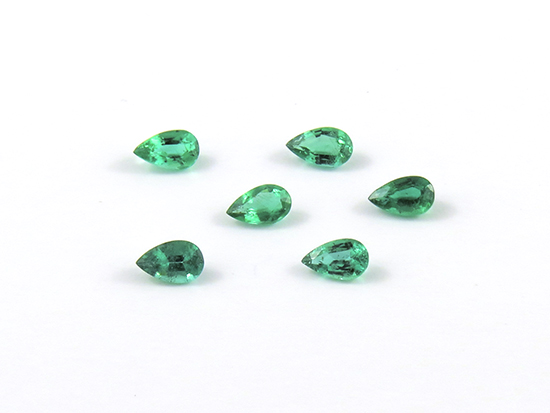
Emerald, along with diamond, ruby, and sapphire, has always been one of the most treasured precious stones. Emerald is a variety of the beryl species whose vibrant green colour is due to trace amounts of the chemical element chromium (Cr) and sometimes vanadium (V).
Emerald Fact Sheet
All beryls, including emerald, have a vitreous lustre and a hardness of 7.5 -8.0 on the Moh’s scale. However, emerald, because it is often included (emerald “garden”) is particularly fragile. This is why it is often fashioned as a square or rectangle with beveled corners.
Producing Countries
Emerald deposits are found primarily in Colombia, Brazil, Zambia, and Zimbabwe. There are also deposits in Siberia, India, Pakistan, and Egypt. Certain inclusions found in emeralds are associated with specific deposits providing gemmologists with a way to determine the geographic origin of some stones.
Emerald crystals form in metamorphic and hydrothermal environments. Some emerald crystals, found mainly in Colombia, contain dark coloured mineral intergrowth in the shape of a six-armed star. These are called Trapiche emeralds and when cut as cabochons or slices the dark star shape produces a beautiful effect.
Is emerald treated?
Most emeralds contain fissures and they are often treated with a process called fracture filling. The gem is immersed in oil and gently heated in a vacuum chamber. This allows the oil to penetrate the surface reaching fractures making them less visible and thereby improving the stone’s transparency and appearance. The trade considers this an acceptable treatment and the majority of emeralds have been treated in this way. The treatment is not permanent however it can be repeated if needed. Emeralds may also be dyed to improve their colour and this treatment should always be disclosed.
Emerald in jewellery
Emeralds are a staple on the world’s red carpets and since antiquity have been a favorite of celebrities and royals alike.
Alexandrite and pearl ( june)
Pearl
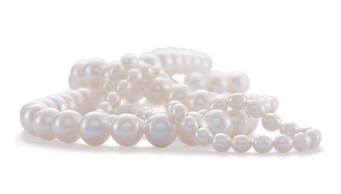
Freshwater pearls
Freshwater pearls include all types of pearls found in river mussels or freshwater lake mussels. Some varieties of mussels can receive up to 60 pearl grafts at a time. These pearls vary between 1mm (seed pearls) and 30 mm for very large baroque pearls. Several forms of freshwater pearls are available on the market such as: round, semi-round, potato, button, semi-baroque, baroque, keshi, fireball, as well as certain forms grown using preformed cores such as pellets, hearts, stars or flowers. These pearls are found in white, cream to slightly silvery, to a wide variety of shades of pink, purplish and coral. China is by far the largest producer of freshwater pearls, although there is also production on a much smaller scale in Japan, the United States and Vietnam, among others.
Akoya pearls
Saltwater cultured pearls from the Akoya oyster Pinctada fucata martensii. These pearls are typically round, ranging from very pale pink to white, more or less pronounced shades of cream, and rarely bluish gray. On the market, we find mostly Akoya pearls between 6 and 8 mm although they exist between 4 and 9 mm and exceptionally up to 11 mm. Japan is the largest producer of Akoya pearls, but Hong Kong, South Korea, Vietnam and Sri Lanka also produce smaller quantities. The term "Japanese pearl" usually refers to this type of pearl.
South seas pearls
In general, this term refers to all saltwater pearls produced in the region between the Philippines, Indonesia, Australia and French Polynesia. However, the pearls of the South Seas are mainly pearls from the oyster Pinctada maxima. You may also hear the expression Gold-lipped oyster or White-lipped oyster to describe this same mollusc. These pearls are usually large (between 8 and 19 mm) and vary in color from white to silvery white to gray and golden white to brilliant gold. The main producing countries are Burma and Australia.
Tahiti pearls
Also known as black pearls, Tahitian pearls exist in a wide variety of natural colors, from very light gray (sometimes even white) to very dark gray, passing through a wide variety of colored highlights: green, golden, coppery, bluish, pink or purplish. These pearls are derived from the oyster Pinctada margaritifera and as the name suggests, are mainly found in French Polynesia. They are usually between 8 and 18 mm, but more frequently are between 9 and 12 mm. Although we are seeing Tahitian pearls on the market between 6 and 8 mm, these sizes are still rare and marginal.
Alexandrite
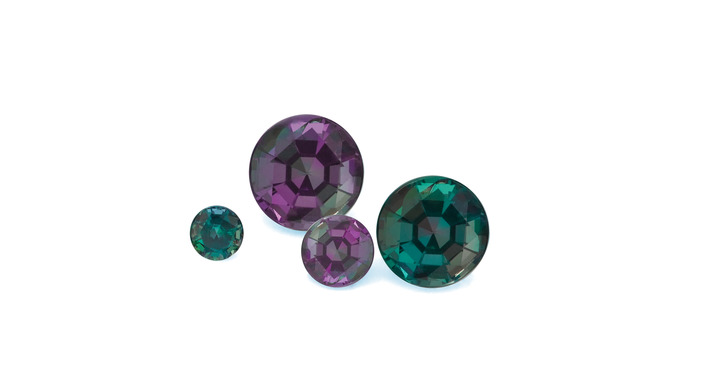
Chrysoberyl, traditionally considered as ‘semi-precious, is actually the name of a gem species that has three important gem varieties. When the term chrysoberyl is used alone it usually refers to the lesser-known greenish yellow variety. The other two gem varieties are chrysoberyl cat’s eye and alexandrite.
Chrysoberyl cat’s eye is usually yellow to yellowish-green and displays a chatoyancy (cat’s eye) effect. Alexandrite displays a colour change effect appearing red to purplish-red in incandescent light and green in daylight. Chrysoberyls form in pegmatites or high pressure metamorphic rock. Rough chrysoberyl often presents as tabular or twinned crystals.

Alexandrite is the chrysoberyl variety that displays a colour change effect. This optical phenomenon is caused by the presence of chromium (Cr) in the gem’s structure which, depending on the light source (daylight or incandescent), absorbs visible light producing different colours. Alexandrite is the most sought after and expensive chrysoberyl variety. Very rare specimens of alexandrite can display both a colour change effect and a cat’s eye effect.
Gemmologists can easily identify alexandrite by its diagnostic chromium (Cr) spectrum. Synthetic alexandrite is common on the market and gemmologists rely on the presence of certain inclusions in order to distinguish natural gems from synthetic versions. Discovered in 1830 in Russia’s Ural Mountains, alexandrite was named in honour of the young Tsar Alexander II. The green and red colours shown by alexandrite were the official colours of Imperial Russia and the gem quickly became a favourite in its homeland. Today, the main source of gem quality alexandrite is Brazil. The gem’s size, colour saturation, clarity, and intensity of the colour change effect will all have an impact on value. Most alexandrites on the market are under 1.00 carat and larger sizes can sell at a significant premium. Alexandrite is the birthstone for the month of June and the gemstone for the 55th wedding anniversary.
Chrysoberyl Fact Sheet
All chrysoberyl varieties display a bright vitreous lustre and have a hardness of 8.5 on the Mohs scale. Their excellent toughness, resistance, and stability make them suitable for all styles of jewellery.
Chrysoberyl in Jewellery
Chrysoberyl’s excellent hardness, stability, and toughness have made it very popular with jewellers and consumers alike. It is suitable for all types of jewellery and will retain its beauty over time. Cat’s eye and alexandrite are particularly popular with gem enthusiasts and collectors.
Ruby (july)
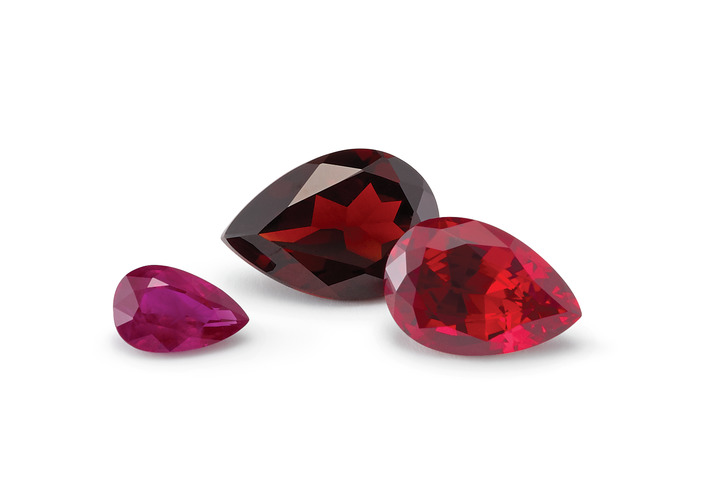
Ruby, along with sapphire, emerald, and diamond has always been one of the most important precious gemstones. Ruby is a variety of the corundum gem species. Sapphire and fancy coloured sapphires are also varieties of corundum.
All members of the corundum species share a common chemical composition and crystal structure while trace amounts of different chemical elements are responsible for the various colours of the different varieties. These elements absorb portions of the visible light spectrum producing the different colours we perceive. Ruby owes its dark pinks and rich, vibrant reds to the presence of chromium (Cr) in its structure.
Red corundum is called ruby, blue corundum is known as sapphire and all other colours are considered fancy coloured sapphires and are named for their particular hues for example: pink sapphire, yellow sapphire, green sapphire etc. The most sought after fancy coloured sapphire is the orangey pink variety known as Padparadscha which means ‘lotus flower’ in Sinhalese.
Ruby and other corundum varieties are amongst the few precious gems that possess all the necessary qualities making them ideal for use in jewellery. All corundum varieties display a bright vitreous lustre, have a hardness of 9 on the Mohs scale, and are extremely resistant and stable. Ruby can also display a six or rarely twelve-rayed star effect.
Producing Countries
The most important ruby deposits are found in Myanmar, Tanzania, and Mozambique. Other sources of ruby include Thailand, Vietnam, Sri Lanka, Pakistan and Afghanistan.
Advanced laboratory testing can help determine the geographic origin of some rubies. Certain localities, such as Myanmar, can command a premium on today’s ruby market.
Ruby crystals can be found in metamorphic and alluvial deposits. Rough ruby crystals usually present as short, six-sided, prismatic shapes. However, those found in alluvial deposits that have spent extended periods being transported by rivers may appear as water worn pebbles.
Is ruby treated?
Ruby is routinely heated to improve its colour by eliminating brown or blue nuances. This treatment is permanent and is considered acceptable by the gem-trade. Some lower quality rubies may contain numerous surface-reaching fractures. These rubies can be treated by filling the fractures with various substances (most commonly lead glass) in order to make the fractures less visible. Rubies treated in this way will have a significantly lower value than an untreated or simply heated ruby of similar appearance. This treatment is not permanent and acids commonly used in jewellery making and cleaning can damage the glass filling. This type of treatment is easily detected by gemmologists and must always be disclosed when selling, as it is not stable. Pierres de Charme does not buy or sell lead glass fracture filled rubies.
Ruby in jewellery
Due to its very durable nature, ruby is well suited for all types of jewellery. Ruby remains one of the most desirable and valuable gems of the world. It is also the birthstone for the month of July.
Peridot (august)
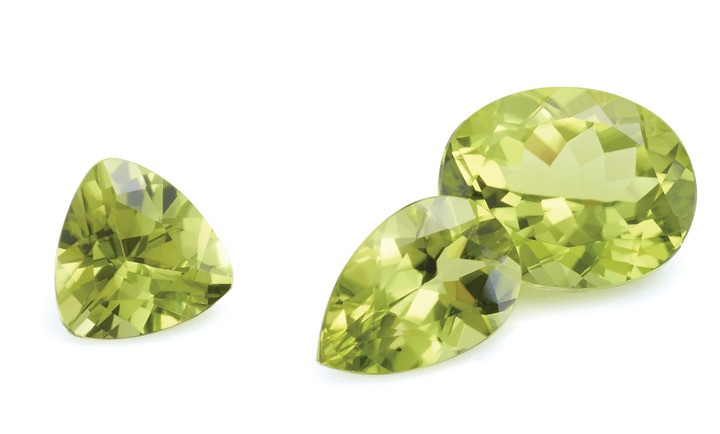
Peridot, traditionally considered as ‘semi-precious’, is a fine gem and member of the olivine isomorphic series. Since antiquity, peridot has been valued for its characteristic vivid green colour.
Peridot is one of the few gemstones that displays a single and consistent colour due to the presence of iron (Fe), which is an essential component of its chemical composition whereas most gems owe their colour to small amounts of chemical elements present as impurities in their structure.
Peridot Fact Sheet
Peridot has a vitreous lustre and a moderate hardness of 6.5 on the Mohs scale. Special attention is suggested when wearing peridot jewellery such as rings.
Producing Countries
Important peridot deposits are found in China, Myanmar, Pakistan, and the United Sates. Peridot is found in very hard host rock material that was transported to the surface by ancient volcanic eruptions. Peridot is rarely found as whole orthorhombic prisms and more commonly found as rounded or broken crystal fragments.
Is peridot treated ?
Peridot is rarely treated however, heavily fractured material can be fracture filled to improve the clarity and durability. Some very dark peridots can be heat treated to lighten the colour.
Peridot in Jewellery
Peridot’s characteristic colour has made it a popular choice in jewellery. It’s moderate hardness of 6.5 makes it best suited for pendants or earrings. However it can also be worn in rings where the choice of setting style provides some protection for the stone.
Peridot is sensitive to acids and contact should be avoided with cosmetic products including perfume and hairspray.
Value and Quality Criteria
Colour is the most important quality criteria for peridot with a rich deep green being the most desirable. Most peridots show slight hints of yellow. Many peridots in the market are ‘eye-clean’ meaning no inclusions are visible without magnification. Stones with dark or easily visible inclusions will have a significantly lower value.
Size will also have an influence on value and large peridots are rare and will command a premium.
Fun Fact
Some peridot comes from outer space! In fact, peridot has been found in meteorites.
Sapphire (september)
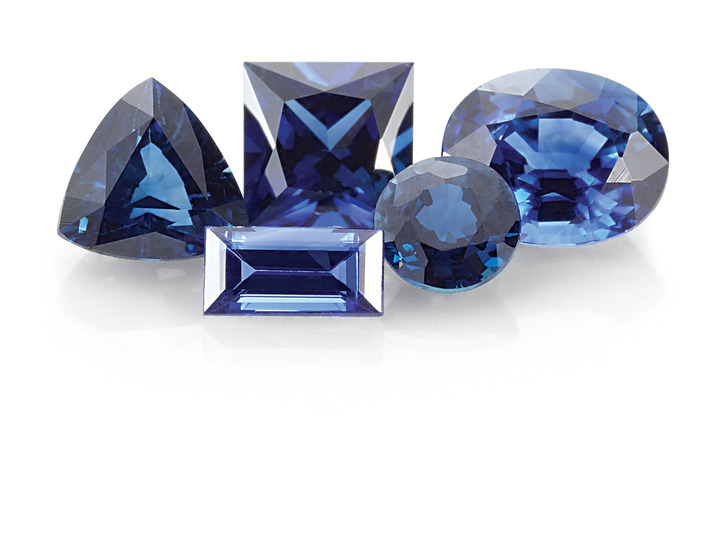 Sapphire, along with ruby, emerald, and diamond has always been one of the most important precious gemstones. Sapphire is a variety of the corundum gem species whose members also include ruby and fancy coloured sapphires.
Sapphire, along with ruby, emerald, and diamond has always been one of the most important precious gemstones. Sapphire is a variety of the corundum gem species whose members also include ruby and fancy coloured sapphires.
Many people don’t know that sapphire comes in all the colours of the rainbow.
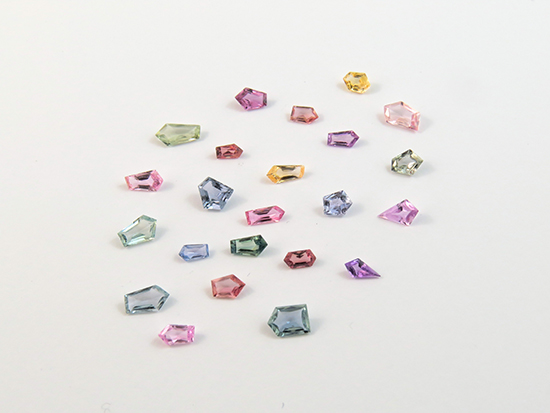
All members of the corundum species share a common chemical composition and crystal structure while trace amounts of different chemical elements are responsible for the various colours of the different varieties. Sapphire, when blue, is coloured by small amounts of iron (Fe) or a combination of iron and titanium (Ti). These elements absorb portions of the visible light spectrum producing the blue colour we perceive.
All shades of blue corundum are referred to as simply sapphire and red corundum is called ruby. All other colours are considered fancy coloured sapphires and are named for their particular hues for example: pink sapphire, yellow sapphire, green sapphire etc. The most sought after fancy coloured sapphire is the orangey pink variety known as Padparadscha, which means ‘lotus flower’ in Sinhalese.
Sapphire Fact Sheet
Sapphire and all corundum varieties are amongst the few precious gems that possess all the necessary qualities making them ideal for use in jewellery. All corundum varieties display a bright vitreous lustre, have a hardness of 9 on the Mohs scale, and are extremely resistant and stable. Sapphires can also display a six or rarely twelve-rayed star effect.
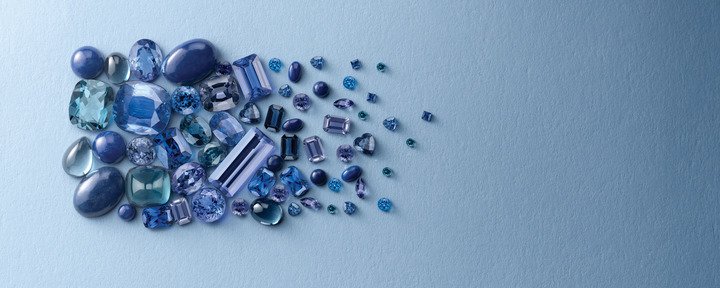
Producing Countries
The most important sapphire deposits are found in Sri Lanka, Myanmar, and Thailand. Other producing countries include Australia, Cambodia, and the Unites States.
Advanced laboratory testing can help determine the geographic origin of some sapphires. Certain geographic origins such as Kashmir can have a significant impact on the gem’s value. It is important to note that the term ‘Kashmir’ is used in two different ways in the trade. In some contexts it is used to indicate that the origin of the sapphire is the famed deposits of Kashmir known for their exceptional quality gems however, it can also be used as a descriptive term meaning that the blue of a certain sapphire is reminiscent of the rich hues seen in sapphires from Kashmir.
Sapphire crystals are found in both metamorphic and alluvial deposits. Sapphires generally present as six sided bipyramids or prismatic forms. . However, those found in alluvial deposits that have spent extended periods being transported by rivers may appear as water worn pebbles.
Is sapphire treated?
Sapphires are routinely treated to improve their appearance. Different heating temperatures and conditions can produce a vast array of results: dark stones can be lightened, light stones can be darkened, inclusions can be dissolved to improve the clarity, and inclusions can be introduced creating star effects. These treatments are stable and many can also be used to improve the appearance of fancy coloured sapphires.
Sapphires can also be treated using a process called diffusion. Pre-facetted gems are heated in an iron rich environment causing the iron to penetrate into the sapphire making it blue. Due to their size, the iron atoms can only penetrate the surface of the stone. Surface diffusion can also be performed on fancy colour sapphires such as yellow sapphires where nickel is used to enhance the colour. This treatment s not stable because the colour penetration is very shallow and will disappear if the stone is re-polished or re-cut. Gemmologists can easily identify this treatment and Pierres de Charmes does not buy or sell surface diffusion treated sapphires.
There is another diffusion treatment called ‘bulk diffusion’ primarily used to improve the appearance of fancy coloured sapphires. This treatment uses beryllium (Be), a smaller chemical element that can penetrate the entire stone. Beryllium diffusion can produce many different colours including yellow, orange, and the orangey-pink hues of Padparadscha sapphire. This treatment is more stable than surface diffusion as the colour will not be removed if the stone is re-polished.
The gem trade considers heat treatments acceptable whereas diffusion treatments should always be disclosed at the point of sale.
Sapphire in Jewellery
For centuries, sapphire has been prominently featured in jewellery. It’s hardness, stability, and toughness makes it suitable for all types of jewellery. Sapphire’s endless shades of blue have made it one of the most popular gems around the world.
Tourmaline (october)
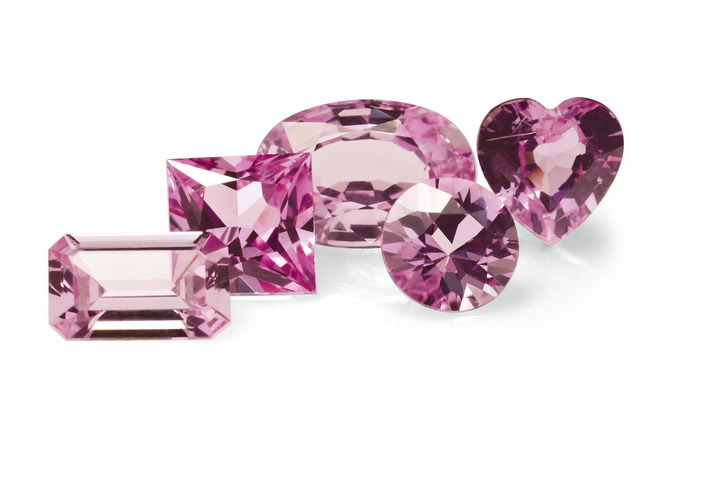 Tourmaline is a popular choice amongst jewellers primarily for its incredible range of colours. Tourmaline’s many varieties represent the entire spectrum of colours.
Tourmaline is a popular choice amongst jewellers primarily for its incredible range of colours. Tourmaline’s many varieties represent the entire spectrum of colours.
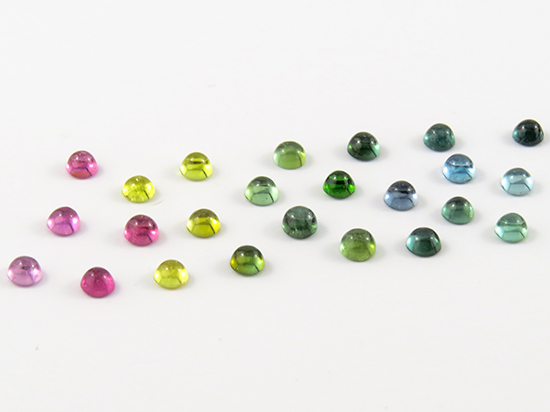
Commercially, there are many trade names given to specific colours of tourmaline and many people may be unaware that they are tourmalines.
Some examples include: rubellite for red tourmalines, indicolite for dark blue tourmaline, and paraïba for vibrant neon blue and bluish-green tourmalines coloured by the presence of copper in their structure. The term “paraiba” has been the subject of great debate in the gem industry. Some believe that the term should be reserved for copper bearing tourmalines that are from Brazil’s Paraïba province while others claim that any copper bearing tourmaline, regardless of origin, can be called Paraïba. For bright blue stones that come from deposits outside of Brazil it is preferable to use terms such as ‘paraiba-like’ or ‘cuprian’ (meaning copper bearing).
It is not uncommon to find tourmalines that show more than one colour at a time. In some cases rough crystals show pink cores surrounded by green exteriors. Tourmaline with these concentric colour zones is often sliced like its namesake “watermelon” to showcase the contrasting colours. In other cases different colours appear along the length of the crystal and often these “parti-coloured’ tourmalines are fashioned to show multiple colours in the same stone. Tourmaline can also display a cat’s eye effect.
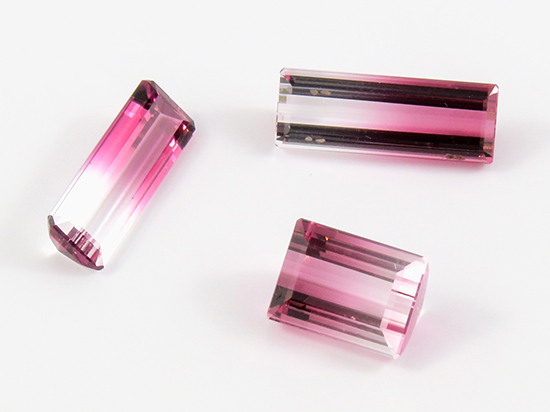
Tourmaline Fact Sheet
As a general rule tourmaline is stable and resistant with a hardness of 7 to 7.5 on the Moh’s scale. However, some tourmalines may have numerous fracture-like inclusions that can weaken the stone. Tourmaline of all colours has a vitreous luster.
Producing Countries
Much of the world’s tourmaline comes from deposits in Brazil. Other producing countries include: Mozambique, Madagascar, Namibia, Tanzania, Afghanistan, Pakistan, Russia, and the United States.
Tourmaline crystals often form in pegmatites. They are typically long 3, 6, or 9-sided prismatic crystals with slightly rounded and heavily striated (lengthwise) prism faces.
Is tourmaline treated?
Tourmaline can be heated to lighten dark tones or irradiated to intensify the colour. The latter is often used to achieve the rich reds of rubellite. Colours resulting from these treatments are stable.
Many Paraïba-like copper bearing tourmaline start out as violet, pink or grey stones. A heat treatment is used to create the electric blue and greenish blue colours associated with paraïba tourmaline.
As with many gems that have surface-reaching fractures, tourmaline can be fracture filled using oils or resins. Oils improve the appearance of the gem by making the fractures less visible. Resin fillers will have the same visual effect while also enhancing the gem’s durability. Presence of these treatments should always be divulged.
Tourmaline in Jewellery
Tourmaline is widely used in jewellery and its growing popularity stems from its incredible range of colours and its durability. Many tourmalines available in the market are relatively affordable compared to other gems. Tourmaline is the birthstone for the month of October and it is the gemstone for the 8th wedding anniversary.
Value and Quality Criteria
Colour is the primary consideration when it comes to value; the more vivid and intense the colour the more valuable the gem. Clarity also plays an important role in value and, in general, green and blue tourmalines have fewer inclusions than red and pink varieties. Therefore slightly included pink and red tourmalines are judged less harshly than included blue and green stones.
The quality of the cut as well as the choice of cut style can also influence value. Tourmaline is most often found as elongated crystals and this explains why many facetted tourmalines are rectangular in shape. As with all gems, size has a direct impact on value. Currently there are fewer large rough tourmalines being found and this is reflected in the market with larger facetted stones selling at a premium.
Fun Fact
As recently as the 18th Century tourmaline was often mistaken for other gems with green tourmaline being confused with emerald, rubellite being taken for ruby and indicolite believed to be sapphire. Even the name tourmaline comes from toramalli meaning “mixed gems” in Sinhalese.
Topaz (november)
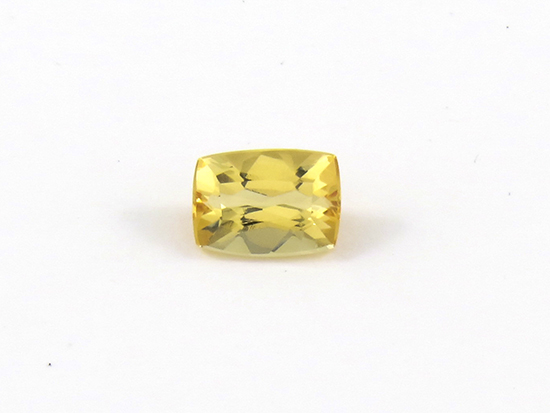
Topaz, traditionally considered ‘semi-precious’, is a fine gem that can be found in an amazing array of colours including: red, orange, yellow, brown, blue, and colourless. Different colour varieties can have very different values.
The most sought after colours are the reds and orangey-pinks called Imperial topaz. Imperial topaz is significantly more expensive than other colours especially blue topaz.
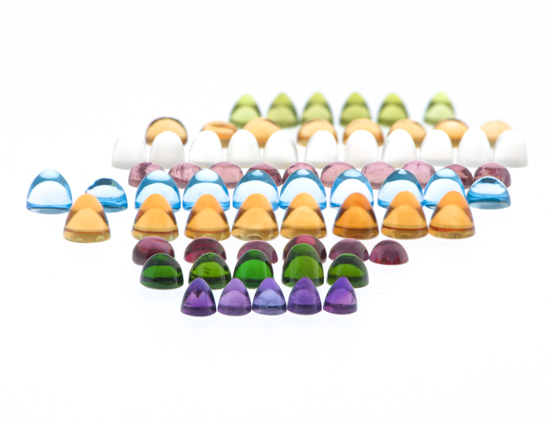
Producing Countries
Brazil is the primary source for Imperial topaz and other gem quality topaz. Other producing countries include Australia, Japan, Madagascar, Myanmar, Mexico, Pakistan, Russia, Sri Lanka, Zimbabwe, and the United states. Many sources outside Brazil produce mainly commercial grade goods that are treated to become blue.
Is topaz treated ?
Although natural blue topaz exists, most blue topaz on the market is a result of treating colourless topaz with a combination of irradiation and heat. This treatment is stable and poses no risks. Pink topaz is also often the result of treatment; brown or yellow topaz is heated to get various shades of pink.
Colourless topaz is often treated with a chemical coating process that produces a wide variety of colours. This type of treatment is generally applied to the stone’s pavilion and may show an iridescent effect on the surface of the stone. It is easily detected with magnification and should be treated with care, as it is not permanent.
Topaz in Jewellery
Topaz has always been a popular choice with both jewellers and clients. Its hardness, toughness, and stability make it suitable for all types of jewellery and allow it to maintain its beauty over time. Gemstone enthusiasts enjoy the affordability of many topaz varieties especially blue topaz.
Imperial topaz is the birthstone for November and the gemstone for the 23rd wedding anniversary while blue topaz is the birthstone for December and the gemstone for the 4th wedding anniversary.
Value and Quality Criteria
Intense and saturated colours will have more value. Clarity and size are important value criteria for topaz. The quality of the cut will also have an impact on the gem’s overall appearance and value.
The most desirable topaz colours are the reds, orangey reds, and pinkish oranges of Imperial topaz that are caused by small amounts of chromium present in the structure. Less than 0.5% of all gem quality topaz is red.
Fun Fact
Modern science has allowed manufacturers to make synthetic versions of many natural gemstones. Synthetic gems have the same physical and optical properties as their natural counterparts. Natural topaz’s abundance and affordability make it one of the few gems not grown in laboratories.
Zircon (december)
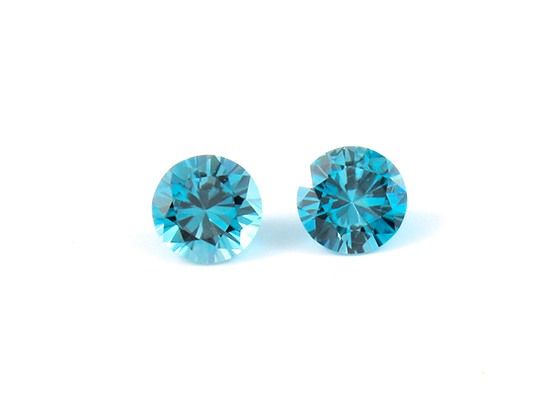
Zircon, traditionally considered as ‘semi-precious’, is a fine natural gemstone with a sub-adamantine lustre and a high dispersion (also called ‘fire’). Zircon comes in a wide range of colours including yellow, brown, orange, red, violet, blue, and green.
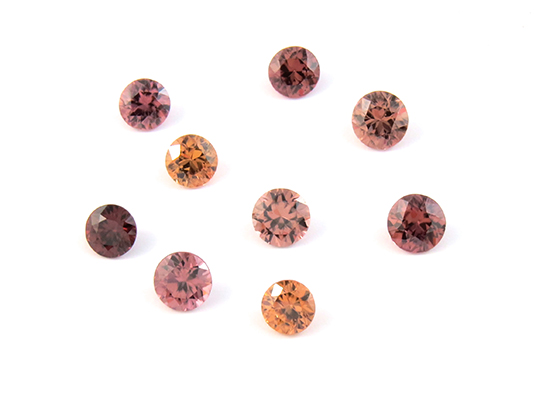
Zircon can also be colourless and when it is it can easily be mistaken for diamond. It is important not to confuse zircon with cubic zirconia (CZ), which is sometimes referred to as ‘zircon’. CZ is a man-made product that resembles natural zircon and diamond with high lustre and dispersion. CZ is used as an inexpensive alternative to diamond in jewellery.
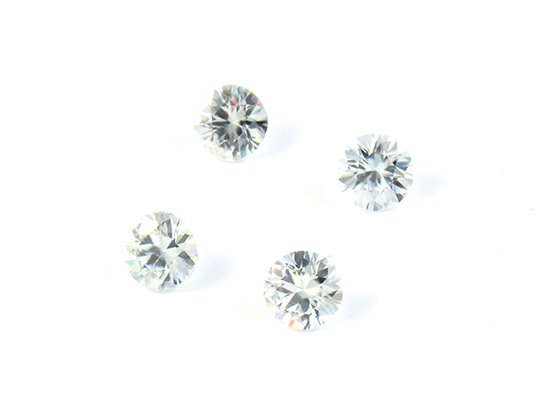
Zircon contains small amounts of radioactive elements that can, over time, alter its crystalline structure producing what is called metamict or ‘low’ zircon. When this occurs the physical and optical properties become different from those of ‘high’ zircon. The radioactive elements present in zircon do not make it radioactive and it poses no threat when worn in jewellery. The descriptions and details provided in this text refer to ‘high’ zircons.
Zircon Fact Sheet
Zircon is valued for its high dispersion and bright vitreous to sub-adamantine lustre. It is usually cut to maximize brilliance and fire. Zircon has a hardness of 6.5 – 7.5 on the Mohs scale and has a low to moderate toughness.
Producing Countries
Major zircon deposits are found in Myanmar, Cambodia, Sri Lanka, and Thailand. Deposits are also found in Brazil, Korea, Mozambique, Nigeria, Tanzania, Vietnam, and France. Zircon is found predominantly in secondary, often alluvial, gem gravels.
Is zircon treated?
Heat is the most common treatment for zircon. Many brownish-red zircons are heated to produce blue, golden yellow, or colourless stones. Heat treatments can also reverse the internal destruction caused by radioactive elements transforming a ‘low’ zircon into a ‘high’ zircon. It should be noted that although many are treated in a lab some zircons can be altered by heat in their natural geological environments.
Zircon in Jewellery
Zircon’s high lustre and dispersion have made it a popular choice in jewellery. Zircon chips fairly easily and has a moderate hardness which makes it best suited for earrings or pendants. It can be set in rings where the setting style offers some protection for the stone and clients should be careful to avoid hard surfaces or sharp impacts.
Zircon is the birthstone for the month of December.
Value and Quality Criteria
Size, colour saturation, and clarity are the main quality criteria for zircon. The quality of the cut will have a major impact on the appearance and value of the stone.
Fun Fact
A zircon found in Australia is considered to be the oldest known mineral on the planet with an age of 4.4 billion years.
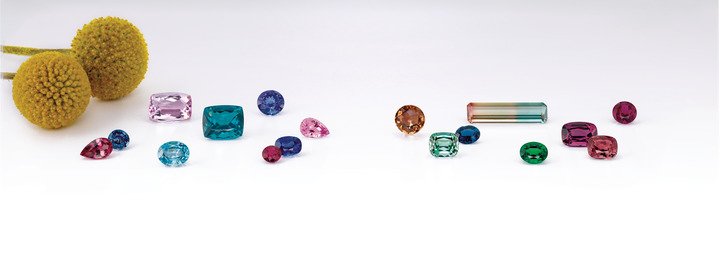
Text ; Bénédicte Lavoie (FGA) Pierres de Charme

 The creation of this website was realized with the financial help of the SODEC.
The creation of this website was realized with the financial help of the SODEC.